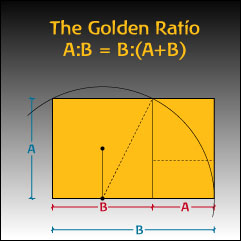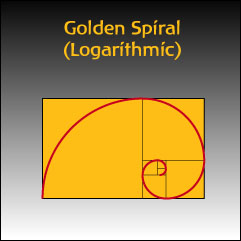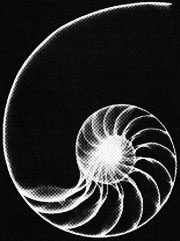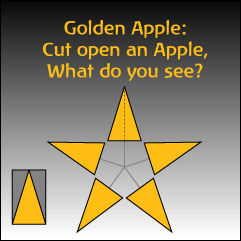
To see the world in a grain of sand, and heaven in a wildflower.
(William Blake)
Sacred Geometry - The Golden Logos
The Golden Proportion, expressed in equation form:
A:B = B:(A+B)
This is the formula of the celebrated golden section, a uniquely
reciprocal relationship between two unequal parts of a whole,
in which the small part stands in the same proportion to the large part as the
large part stands to the whole. (Gyorgy Doczi, The Power of Limits)

--| Robert Lawlor on the Golden Mean |---
A proportion is formed from ratios, and a ratio is a comparison of two
different sizes, quantities, qualities or ideas, and is expressed by the
formula a:b. A ratio then constitutes a measure of difference. The
perceived world is then made up of intricate woven patterns of...
differences... A proportion, however, is more complex, for it is a
relationship of equivalency between two ratios, that is to say, one
element is to a second element as a third element is to a fourth:
a is to b as c is to d, or a:b::c:d ...
When we further limit ourselves to three elements, or terms, we find that
the determination becomes more exacting through the reduction of the
number of elements involved. Thus one element is to a second element as
the second element is to a third: a:b::b:c. Here the extremes are bound
together by a mean term, b ...
There is one, and only one, proportional division which is possible with
two terms. This occurs when the smaller term is to the larger term in the
same way as the larger term is to the smaller plus the larger. It is
written a:b::b:(a+b). The largest term (a+b) must be a wholeness or unit
composed of the sum of the other two terms.
Historically this unique geometric proportion of two terms has been given
the name "Golden Proportion."...The fact that it is a three-term
proportion constructed from two terms is its first distinguishing
characteristic, and is parallel with the first mystery of the Holy Trinity:
the Three that are Two. It is first and foremost a proportion, not a
number, a proportion upon which the experience of knowledge (Logos) is
founded.
In a sense, the Golden Proportion can be considered as supra-rational or
transcendent. It is actually the first issue of Oneness, the only possible
creative duality within Unity. It is the most intimate relationship, one
might say, that proportional existence--the universe--can have with Unity,
the primal or first division of One. For this reason the ancients called it
"golden."... Why, it may be asked, cannot Unity simply divide into two equal
parts? Why not have a proportion of one term, a:a? The answer is simply
that with equality there is no difference, and without difference there is
no perceptual universe, for, as the Upanishad says, "Whether we know it or
not, all things take on their exsitence from that which perceives them." In
a static, equational statement one part nullifies the other. An
asymmetrical division is needed in order to create the dynamics necessary
for progression and extension from the Unity. Therefore the F proportion
is the perfect division of Unity: it is creative, yet the entire
proportional universe that results from it relates back to it and is
literally contained within it, since no term of the original division
steps, as it were, outside of a direct rapport with the initial division
of Unity...
St. John wrote of the creative moment or original scission, "In the
beginning was the Word" (or in Greek, logos, meaning a three-term
proportion), "...and the Word was with God" (the phrase 'with God' can
also be read 'in God') "...and the Word was God."
Looking closely at these three phrases one can see that they intuitively
describe the geometric implications of the Golden Proportion:
In the beginning was the Word,
And the Word was with[in] God,
And the Word was God."
(Parabola Magazine - Winter 1991; Robert Lawlor, The Measure of Difference)
--| Harmony by Design, by Astrid Fitzgerald |---
This essential idea of unity is best described in the Eastern tradition
the One, which is the same as Brahman, or pure existence and ultimate
reality, is beyond creation. It is the god Iswara, who is Brahman united
with Maya, the world-appearance, who has the power to create, preserve,
and disolve in a process without beginning or end. Our relationship to
this ultimate reality is expressed by Lawlor's reference to the 'creative
duality.'
The Esha Upanishad, the first of the Ten Principal Upanishads, states:
That [Brahman] is perfect [or infinite],
This [creative or conditioned Brahman] is perfect.
Perfect comes from perfect.
Take perfect from perfect, the remainder is perfect.
(The Ten Pricnicple Upanishads put into English by W.B. Yeats
and Shree Purohit Swami, New York, Collier Books, 1975)
  This universal statement of truth is also a description of the mysterious
nature of the Divine Proportion. The Golden Mean rectangle may be increased
or decreased by the addition of a square, which is symbolic in sacred
geometry of the creation. This increase or decrease does not affect the
proportion (the essence or inherent law). In other words, 'the remainder
is perfect.' By adding an arc within each square, the formation of the
Golden Mean spiral emerges. The outward spiral symbolizes expansion,
creation, and the harmonic unfolding of the implicit order. The inward
spiral shows the way back to the source, the still point where there are
no ripples, where the phenomenal world ceases to exist, which the mystics
describe as union with Brahman.
(Ibid, Astrid Fitzgerald, Harmony by Design)
--| Asymetric Proportionality |---
The proportionality sought by Buddhist and Christian adepts is thus always
asymetrical, tending at one time or another towards one component or
another of the human whole. (This explains why the Golden Mean is not a
1:1 ratio, but a more subtle expression of equilibrium in asymmetry.)
(Ibid, Philip Zaleski, Restoring the Imago Dei)
--| The Dance of Libra |-----
Libra thus seems best understood as a process rather than a result:
it the active moment (inner and outer) of balancing, or trying to maintain
balance, rather than any sort of static or permanent state... another way
to look at the symbol of the scales would be to incorporate the yin-yang
symbolism of the Tao, as Behari does, stating that "the two sides, black
and white, are so balanced that one drives the other in constant motion"
and the opposing forces are not neutralized."
"The moment of harmony will always be the Present Moment,
between balance and imbalance."
The Golden Mean is "equilbrium, seen as a dynamic asymbetrical state
of balance, alive with precarious possibility."
(Ibid, Rob Baker, The Dance of Libra)
--| A Conversation between Richard Temple and Keith Critchlow |-----
RT: I have been trying to understand how, in its absolute essence, the
Golden Mean is the Trinity, the division of unity within itself into two
and expressed in completion as three, yet ever remaining unity.
KC: It is true: the basic idea of a 'mean,' just the concept of a 'mean,'
upon which Aristotle built the whole of his theory of the soul's
perception, was that it is a particular point of balance between two
extremes and threefore it has to be trinitarian. You have to have two
extremes for there to be a mean, but the mean unifies those two and, as you
were saying to yourself, the whole point about the Trinity is the quality
of threeness which is in itself a single thing. 'Threeness' is a single
thing; 'three' is three seperate things.
RT: We learn that the origin of number, like the Absolute in the Universe,
is One: Unity. Creation is two: Unity dividing itself, going outwards from
itself. And three, the Trinity, is the completion of the process that
initiates a motion sending God out into ultimately the very last part of
the universe. The Trinity exist everywhere in the universe. The fact that
we can find the Golden Proportion in plants and in the structure of man
shows that this law is everywhere."
This universal statement of truth is also a description of the mysterious
nature of the Divine Proportion. The Golden Mean rectangle may be increased
or decreased by the addition of a square, which is symbolic in sacred
geometry of the creation. This increase or decrease does not affect the
proportion (the essence or inherent law). In other words, 'the remainder
is perfect.' By adding an arc within each square, the formation of the
Golden Mean spiral emerges. The outward spiral symbolizes expansion,
creation, and the harmonic unfolding of the implicit order. The inward
spiral shows the way back to the source, the still point where there are
no ripples, where the phenomenal world ceases to exist, which the mystics
describe as union with Brahman.
(Ibid, Astrid Fitzgerald, Harmony by Design)
--| Asymetric Proportionality |---
The proportionality sought by Buddhist and Christian adepts is thus always
asymetrical, tending at one time or another towards one component or
another of the human whole. (This explains why the Golden Mean is not a
1:1 ratio, but a more subtle expression of equilibrium in asymmetry.)
(Ibid, Philip Zaleski, Restoring the Imago Dei)
--| The Dance of Libra |-----
Libra thus seems best understood as a process rather than a result:
it the active moment (inner and outer) of balancing, or trying to maintain
balance, rather than any sort of static or permanent state... another way
to look at the symbol of the scales would be to incorporate the yin-yang
symbolism of the Tao, as Behari does, stating that "the two sides, black
and white, are so balanced that one drives the other in constant motion"
and the opposing forces are not neutralized."
"The moment of harmony will always be the Present Moment,
between balance and imbalance."
The Golden Mean is "equilbrium, seen as a dynamic asymbetrical state
of balance, alive with precarious possibility."
(Ibid, Rob Baker, The Dance of Libra)
--| A Conversation between Richard Temple and Keith Critchlow |-----
RT: I have been trying to understand how, in its absolute essence, the
Golden Mean is the Trinity, the division of unity within itself into two
and expressed in completion as three, yet ever remaining unity.
KC: It is true: the basic idea of a 'mean,' just the concept of a 'mean,'
upon which Aristotle built the whole of his theory of the soul's
perception, was that it is a particular point of balance between two
extremes and threefore it has to be trinitarian. You have to have two
extremes for there to be a mean, but the mean unifies those two and, as you
were saying to yourself, the whole point about the Trinity is the quality
of threeness which is in itself a single thing. 'Threeness' is a single
thing; 'three' is three seperate things.
RT: We learn that the origin of number, like the Absolute in the Universe,
is One: Unity. Creation is two: Unity dividing itself, going outwards from
itself. And three, the Trinity, is the completion of the process that
initiates a motion sending God out into ultimately the very last part of
the universe. The Trinity exist everywhere in the universe. The fact that
we can find the Golden Proportion in plants and in the structure of man
shows that this law is everywhere."
 "I came across a defintion of the Golden Mean which states that it is the
unity that includes both what is perceived as well as the perceiver."
"There are two ways [and the Golden Proportion is the only number for
which this is true] mathematically, by which you can place the Golden Mean
between those two points. The lesser in relation the the greater in the
Golden Mean can signify that the outer is the greater and the inner is the
lesser, or it can signify that the inner is the greater and the outer is
the lesser. But the 'mean' is a flucutation in between those two things."
(Ibid, The Golden Proportion: A conversation between Richard Temple and Keith Critchlow)
--| References |---
> Parabola: The Golden Mean, Winter 1991, Vol. XVI, No 4, ISSN: 0362-1596.
- Astrid Fitzgerald
- The Golden Proportion in Your Hand
- Mathsoft - Mathematics of Constants
- Golden Links
"I came across a defintion of the Golden Mean which states that it is the
unity that includes both what is perceived as well as the perceiver."
"There are two ways [and the Golden Proportion is the only number for
which this is true] mathematically, by which you can place the Golden Mean
between those two points. The lesser in relation the the greater in the
Golden Mean can signify that the outer is the greater and the inner is the
lesser, or it can signify that the inner is the greater and the outer is
the lesser. But the 'mean' is a flucutation in between those two things."
(Ibid, The Golden Proportion: A conversation between Richard Temple and Keith Critchlow)
--| References |---
> Parabola: The Golden Mean, Winter 1991, Vol. XVI, No 4, ISSN: 0362-1596.
- Astrid Fitzgerald
- The Golden Proportion in Your Hand
- Mathsoft - Mathematics of Constants
- Golden Links

SUBMIT AN ARTICLE
posted: september 25, 2000
updated: september 27, 2004
|



This universal statement of truth is also a description of the mysterious nature of the Divine Proportion. The Golden Mean rectangle may be increased or decreased by the addition of a square, which is symbolic in sacred geometry of the creation. This increase or decrease does not affect the proportion (the essence or inherent law). In other words, 'the remainder is perfect.' By adding an arc within each square, the formation of the Golden Mean spiral emerges. The outward spiral symbolizes expansion, creation, and the harmonic unfolding of the implicit order. The inward spiral shows the way back to the source, the still point where there are no ripples, where the phenomenal world ceases to exist, which the mystics describe as union with Brahman. (Ibid, Astrid Fitzgerald, Harmony by Design) --| Asymetric Proportionality |--- The proportionality sought by Buddhist and Christian adepts is thus always asymetrical, tending at one time or another towards one component or another of the human whole. (This explains why the Golden Mean is not a 1:1 ratio, but a more subtle expression of equilibrium in asymmetry.) (Ibid, Philip Zaleski, Restoring the Imago Dei) --| The Dance of Libra |----- Libra thus seems best understood as a process rather than a result: it the active moment (inner and outer) of balancing, or trying to maintain balance, rather than any sort of static or permanent state... another way to look at the symbol of the scales would be to incorporate the yin-yang symbolism of the Tao, as Behari does, stating that "the two sides, black and white, are so balanced that one drives the other in constant motion" and the opposing forces are not neutralized." "The moment of harmony will always be the Present Moment, between balance and imbalance." The Golden Mean is "equilbrium, seen as a dynamic asymbetrical state of balance, alive with precarious possibility." (Ibid, Rob Baker, The Dance of Libra) --| A Conversation between Richard Temple and Keith Critchlow |----- RT: I have been trying to understand how, in its absolute essence, the Golden Mean is the Trinity, the division of unity within itself into two and expressed in completion as three, yet ever remaining unity. KC: It is true: the basic idea of a 'mean,' just the concept of a 'mean,' upon which Aristotle built the whole of his theory of the soul's perception, was that it is a particular point of balance between two extremes and threefore it has to be trinitarian. You have to have two extremes for there to be a mean, but the mean unifies those two and, as you were saying to yourself, the whole point about the Trinity is the quality of threeness which is in itself a single thing. 'Threeness' is a single thing; 'three' is three seperate things. RT: We learn that the origin of number, like the Absolute in the Universe, is One: Unity. Creation is two: Unity dividing itself, going outwards from itself. And three, the Trinity, is the completion of the process that initiates a motion sending God out into ultimately the very last part of the universe. The Trinity exist everywhere in the universe. The fact that we can find the Golden Proportion in plants and in the structure of man shows that this law is everywhere."
"I came across a defintion of the Golden Mean which states that it is the unity that includes both what is perceived as well as the perceiver." "There are two ways [and the Golden Proportion is the only number for which this is true] mathematically, by which you can place the Golden Mean between those two points. The lesser in relation the the greater in the Golden Mean can signify that the outer is the greater and the inner is the lesser, or it can signify that the inner is the greater and the outer is the lesser. But the 'mean' is a flucutation in between those two things." (Ibid, The Golden Proportion: A conversation between Richard Temple and Keith Critchlow) --| References |--- > Parabola: The Golden Mean, Winter 1991, Vol. XVI, No 4, ISSN: 0362-1596. - Astrid Fitzgerald - The Golden Proportion in Your Hand - Mathsoft - Mathematics of Constants - Golden Links
